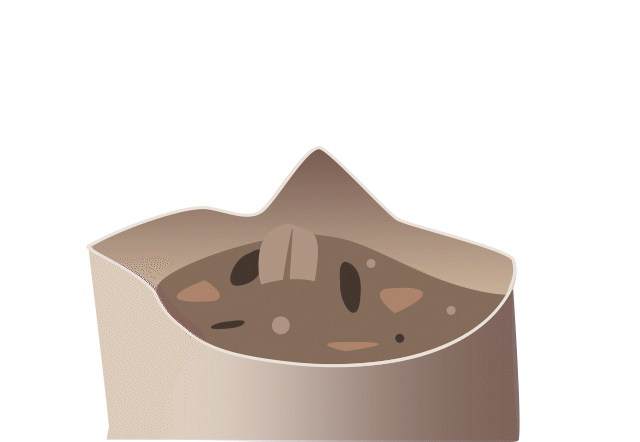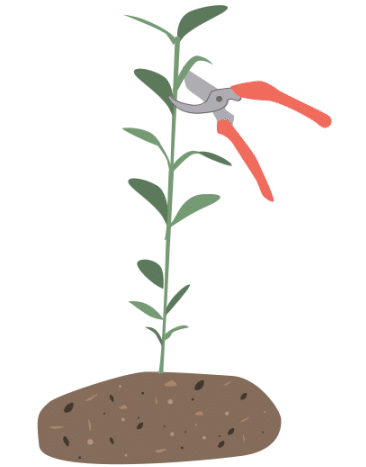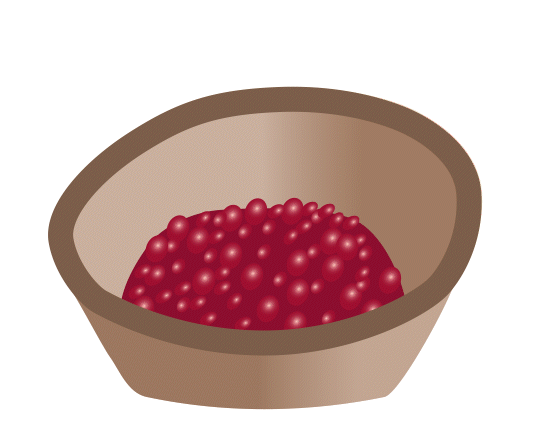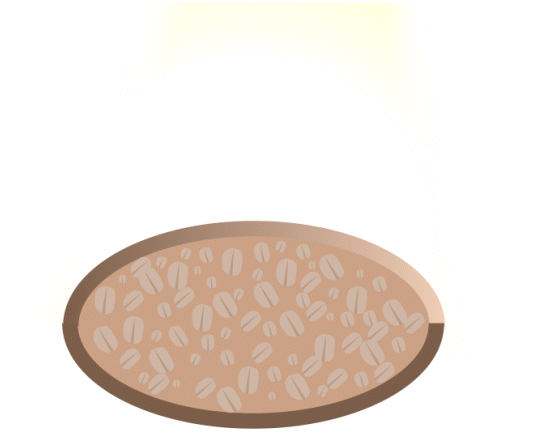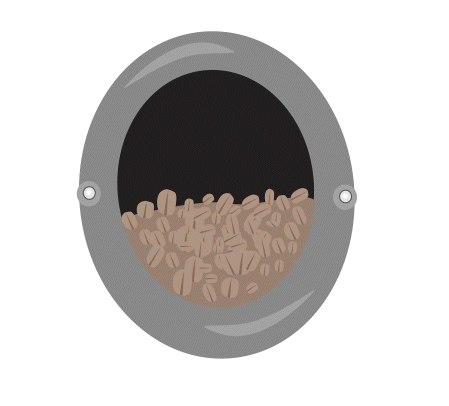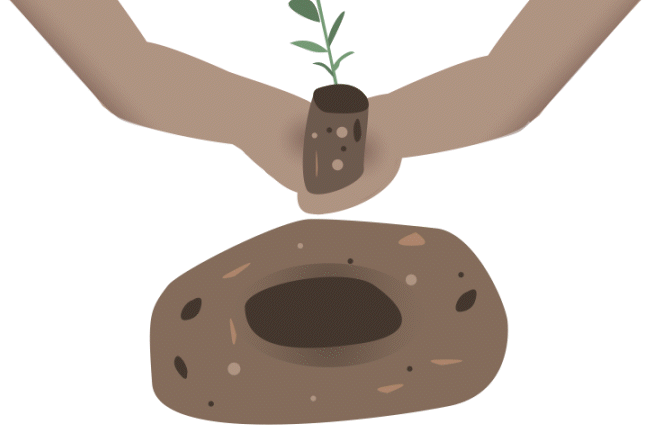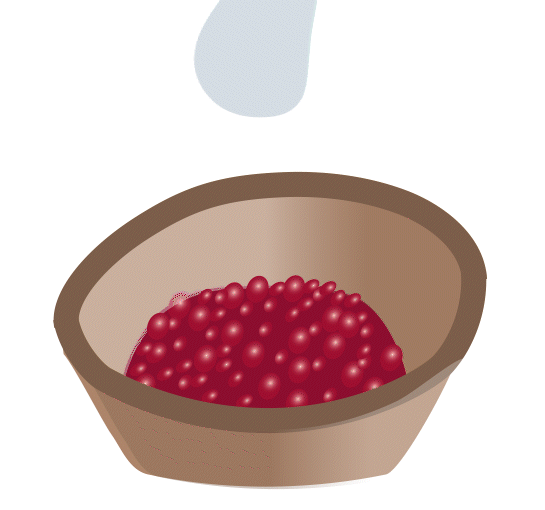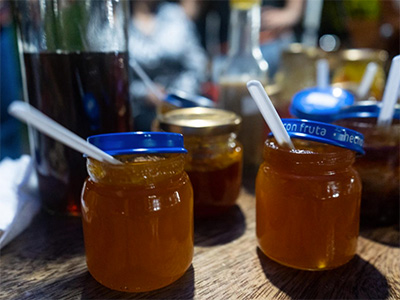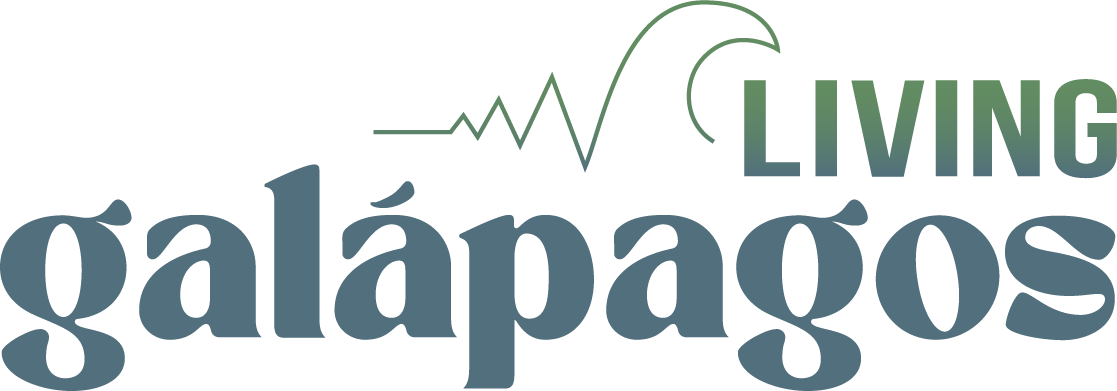Living on the Land
Farmers are shifting their practices to build a sustainable local food system in a place that has long relied on imports.
Living on the Land
Farmers are shifting their practices to build a sustainable local food system in a place that has long relied on imports.
REPORTER
Samuel Garzon
PHOTO
Caroline Bittenbender
VIDEO
Evan Davison
Daniela Rodriguez
INTERACTIVE
Alicia Robbins
Farming on these volcanic islands in the Pacific Ocean is not an easy task. Droughts, extreme weather, and intense competition with mainland imports are just some of the challenges that farmers must survive.
Isabel Vasco, 39, feels a deep connection with species like the yellow warble and woodpecker finch that have found a home on her coffee farm. Located in San Cristóbal’s highlands, Las Tres Marias is one of the many farms working to make island agriculture more self-sufficient and environmentally friendly. The farm has been in her family for over 15 years, and was bought by the joint effort of five generations of women. Vasco is just the most recent.
Vasco is a firm advocate of practicing eco-agriculture; her favorite benefit is the sense of harmony it creates with the land. Eco-agriculture involves the introduction of symbiotic species to support the farm’s ecological sustainability without jeopardizing current or future generations’ ability to use the land’s resources. Due to this technique, finches and other endemic birds of all sizes and colors live and feed throughout Las Tres Marias.
Farming here presents a unique challenge. How to develop a sustainable system for meeting increasing food demand while mitigating harm to a highly fragile environment.
Vasco lived most of her life in Quito, where she moved as a child. She worked in information technology for over 12 years, where doctors on the mainland told Vasco that her job was causing her immense stress and negatively affecting her health. What originally started as a sabbatical year ended with Vasco finding a new profession.
REPORTER Samuel Garzon
PHOTO Caroline Bittenbender
VIDEO Evan Davison | Daniela Rodriguez
INTERACTIVE Alicia Robbins
Farming on these volcanic islands in the Pacific Ocean is not an easy task. Droughts, extreme weather, and intense competition with mainland imports are just some of the challenges that farmers must survive.
Isabel Vasco, 39, feels a deep connection with species like the yellow warble and woodpecker finch that have found a home on her coffee farm. Located in San Cristobal’s highlands, Las Tres Marias is one of the many farms working to make island agriculture more self-sufficient and environmentally friendly. The farm has been in her family for over 15 years, and was bought by the joint effort of five generations of women. Vasco is just the most recent.
Vasco is a firm advocate of practicing eco-agriculture; her favorite benefit is the sense of harmony it creates with the land. Eco-agriculture involves the introduction of symbiotic species to support the farm’s ecological sustainability without jeopardizing current or future generations’ ability to use the land’s resources. Due to this technique, finches and other endemic birds of all sizes and colors live and feed throughout Las Tres Marias.
Farming here presents a unique challenge. How to develop a sustainable system for meeting increasing food demand while mitigating harm to a highly fragile environment.
Vasco lived most of her life in Quito, where she moved as a child. She worked in information technology for over 12 years, where doctors on the mainland told Vasco that her job was causing her immense stress and negatively affecting her health. What originally started as a sabbatical year ended with Vasco finding a new profession.
“I wouldn’t exchange this land paradise for anything that the mainland has to offer,” Vasco said.
“I wouldn’t exchange this land paradise for anything that the mainland has to offer.”
From a young age, Vasco’s mother always fostered a sense of love and appreciation for nature and wildlife in her. Her mother, Mireya Aguas, 66, grew up on the island. For Aguas, harvesting coffee was more of a family pastime. Coffee was only planted on a tiny portion of the land for family consumption, at least until Vasco saw a business opportunity.
Unlike the case with other farms, coffee plants on Las Tres Marias are not arranged in rows or vertical patterns. The setup resembles more of an enchanted coffee forest, which would influence the name of her coffee brand Cafe Embrujo, or enchanted coffee. This “un-organization” allows the plants to grow and expand naturally, absorbing all the volcanic soil rich in nutrients and minerals.
The first cup of coffee that Vasco drank from her beans filled her with an enormous sense of pride. There was a delicate aroma and sweetness caused by the unique acidity of the soil. The surprisingly large harvest was a milestone symbolizing how far she had made it since leaving the mainland. As anticipated, the flavor was not quite what she wanted it to be, but that could be fixed.
Over the last three years, she’s been able to slowly improve her farming techniques and her equipment. Tasks that took her hours to do in the past can now be done by machines in minutes. Roasting the coffee was done in a large pot that had to be mixed manually for hours, now she only has to load an industrial toaster for minutes. Every new harvest is a lesson to improve. For farmers like Vasco, who don’t rely on any type of artificial chemicals, utilizing the Earth’s resources is crucial.
The first harvest took almost eight months; becoming a certified farmer on the island took more than two years, a common issue for any resident who wants to farm in the Galápagos. When Vasco moved to the islands, there were only about three “officially” designated coffee farms and the number has only increased by a handful since then.
Vasco sees herself as part of a movement to make Galápagos the self-sustainable paradise she believes it can be.
Feeding From a Thousand Miles Away
Galápagos imports 75% of its food, with some models predicting that this will rise to 95% by 2037. Food from Ecuador’s mainland, usually delivered by sea in huge cargo ships, can take up to a week to arrive, reducing shelf life. On average, over 1,000 crates of food and basic household items make the 700-mile journey daily from Ecuador’s capital, Guayaquil, to Puerto Ayora in Santa Cruz. From there, it gets distributed to the other islands.
Produce can cost twice as much as it would on the mainland due to the unreliable food systems and because it has to be imported.
Despite laws restricting who can live on the islands, immigration from the mainland and a surge in tourism have strained the island’s capacity to provide for everyone. In the past decade, becoming a farmer on the Galápagos has become almost an impossible task obstructed by local entities and conservationist groups. After all, farmers plant invasive species in an area where keeping them out gets more challenging over time. For example, since their introduction, the blackberry bush and guava trees have escaped agricultural areas and eradicated native plants.
The seeds of these invasive plants are transported on the excrement of the birds, which can spread quickly to large areas that used to be designated for farming through the park.
The Ecuadorian government has established “agricultural” lands where crops can be cultivated legally on the most populated islands—San Cristóbal, Isabela and Santa Cruz. Aside from the more-inhabited parts, the remaining 98% of the islands are entirely protected, leaving farmers with no access to expand more than they already have.
“If a self-sustainable movement can start and thrive in a place like the Galápagos, it can happen anywhere,” Vasco said.
“If a self-sustainable movement can start and thrive in a place like the Galápagos, it can happen anywhere.”
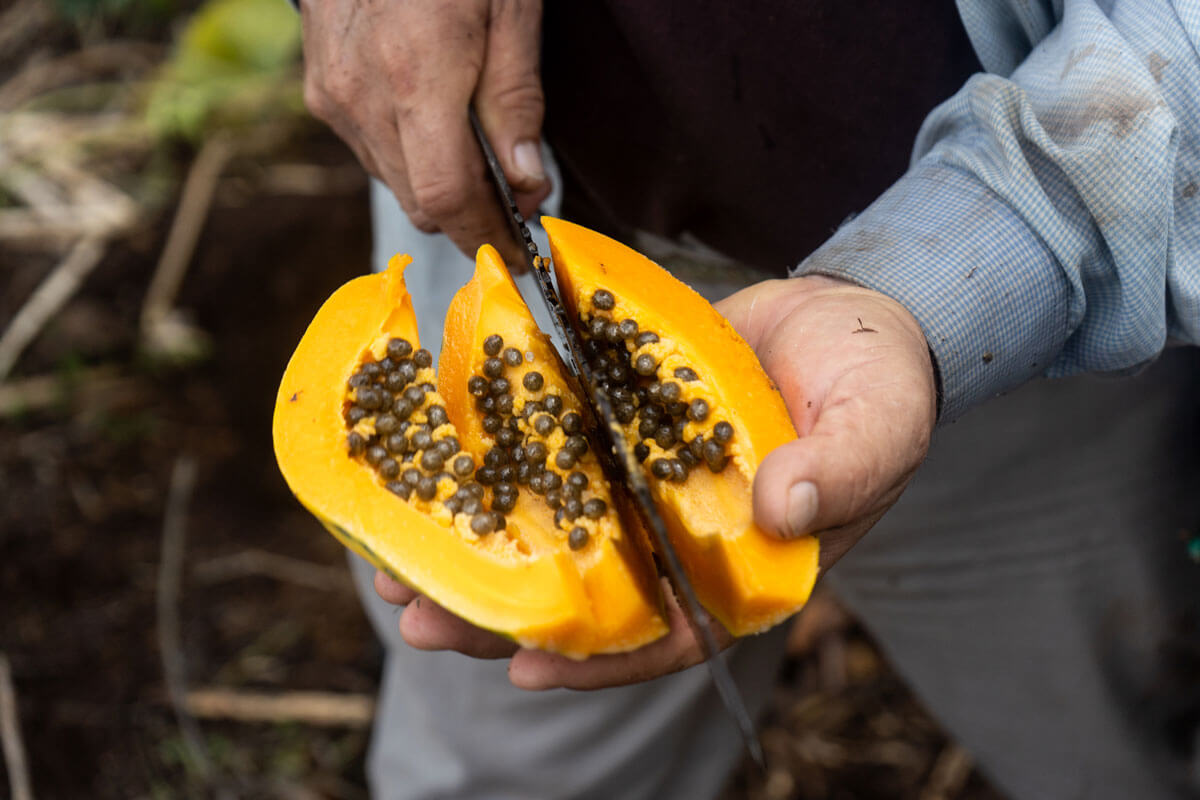
Milton Aguas slices open a papaya at the Hacienda Guadalupe farm on Sunday, March 13, 2022.
Regarding environmental conservation, the Galápagos Islands is arguably the world’s most well-preserved archipelago. It is one of Ecuador’s 24 provinces, with a total population of around 26,00 people, according to the latest survey in 2015, conducted by the INEC, the government agency in charge of population and demographic studies.
In contrast to agriculture, tourism has been the most crucial element of the Galápagos Islands’ economy over the last four decades. Tourism’s rapid growth has been the primary driver of social, economic, and environmental legislation. The industry has sparked a demographic explosion, increasing the demand for goods and services to meet residents’ and tourists’ basic needs.
Due to the legislative constraints, farmers in the past may have been inclined to stay off agricultural land even when it was completely vacant. Forced to look for other lucrative economic ventures, farming has become the last resort for many residents.
People like Vasco make a case that growing any crop a mile from where it will be consumed is more sustainable for the environment than transporting one from over a thousand miles away.
Despite all of these challenges, many farmers dedicated themselves to educating residents and tourists about the vital role of agriculture on the Islands. Different farms like Hacienda Luna and Hacienda Tranquila, located in San Cristóbal, believe that sustainability education should become a top priority for local political and environmental authorities.
How to Create a Sustainable Balance
Sustainable landscapes are distinguished from other conservation and development approaches by their focus on pursuing multiple objectives to meet multiple goals. Communities, governments, businesses, and researchers must all collaborate in an integrated effort to strike a balance between meeting people’s immediate needs and incurring significant long-term costs.
Milton Aguas, Vasco’s uncle, has been a farmer his entire life. His farm, Hacienda Guadalupe, is the central base of operations for products of Dona Elda, his jelly brand. Like many local farmers, he has found other projects to sustain himself since income from farming is insufficient.
Aguas served two terms as mayor of San Cristóbal, a town of approximately 6,000, between 1992 and 2000. More than anyone, he knows the difficulties of balancing human needs and conservation efforts on the island.
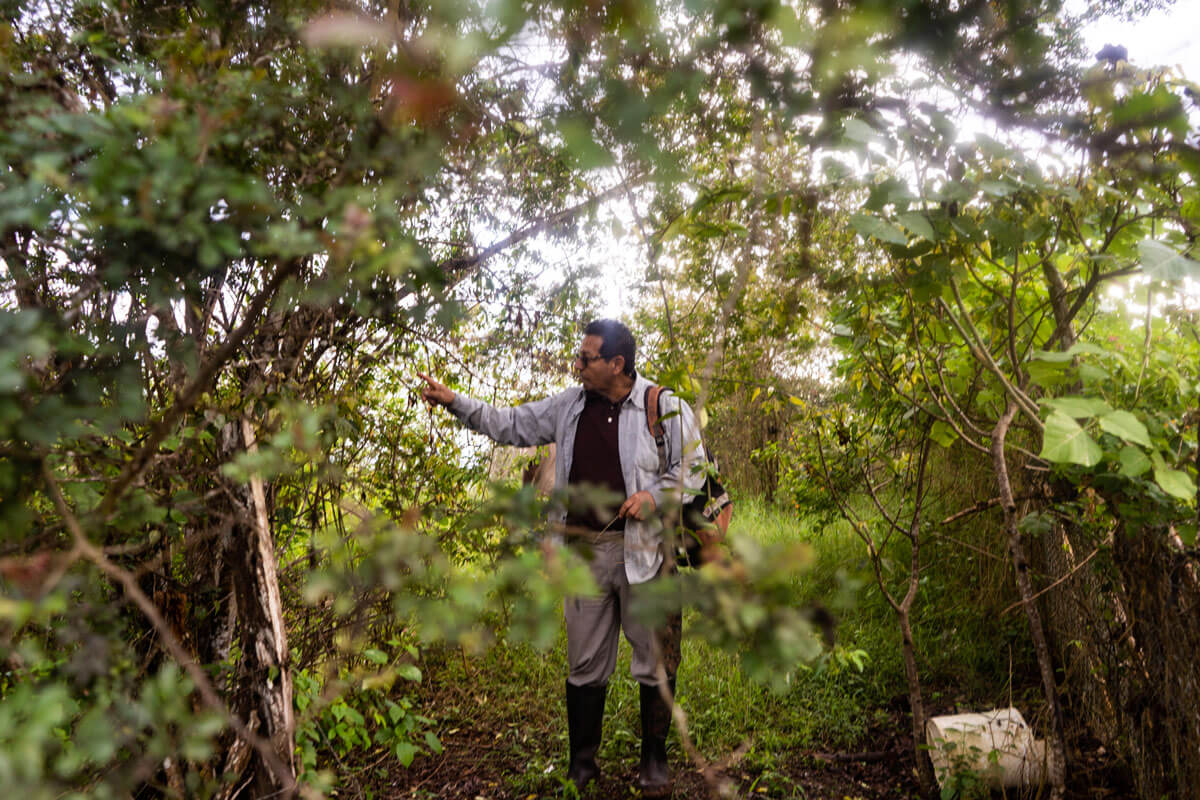
Milton Aguas stands in the middle of what he hopes to soon be an enclosed sanctuary for Galápagos tortoises on Sunday, March 13, 2022. Aguas has had difficulty securing permission from the Galápagos National Park to make this ambition a reality.
Aguas has always seen the issue of land usage from a historical perspective; his family was among the first settlers on the island back in the 1950s, back when the mainland was incentivizing people to move to the island. Agriculture in the Galápagos has gone from being encouraged by the mainland government to being almost prohibited and has always been part of the public discourse on the island.
“In our farm, we try to maintain a balance. We always think about sustainability, which is the defense of four important elements: respect for nature, respect for the people who work the land, respect for society, and respect for the social and economic growth of all people.” Aguas said.
Aguas said that local communities and authorities in the Galápagos Islands should start pursuing self-sufficiency in local production. He believes this could be done through
technological advancements, technical assistance, economic incentives, price and import regulations and public awareness campaigns promoting the consumption of local products.
There is no better way to control invasive species, the majority of which are concentrated in the rural land, than to generate enough income from local market sales to allow farmers to keep their lands cleared and managed for food production.
Agua is a firm believer that a self-sustainable Galápagos is possible and necessary if the population trends continue growing.
Aguas loves to explain the principle of “responsible consumption” which means to find a use for everything produced, wasting no food or raw material at all. Hacienda Guadalupe, being one of the only farms in San Cristóbal with sweet water, is able to self-sustain when it comes to that resource — a luxury that not all farms have. Aguas practices ecotourism on his farm, he takes large groups of mostly tourists and local students around the farm and explains his use of eco-agriculture, in this case, using invasive species to his benefit.
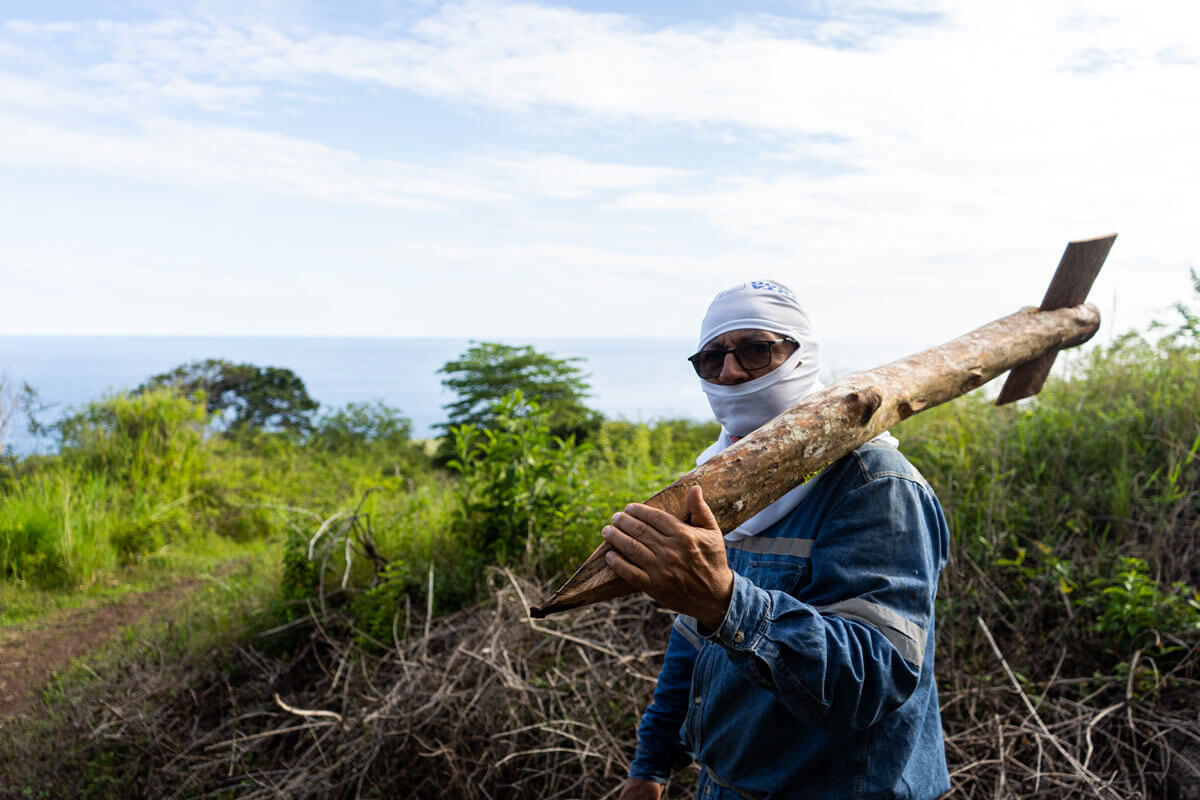
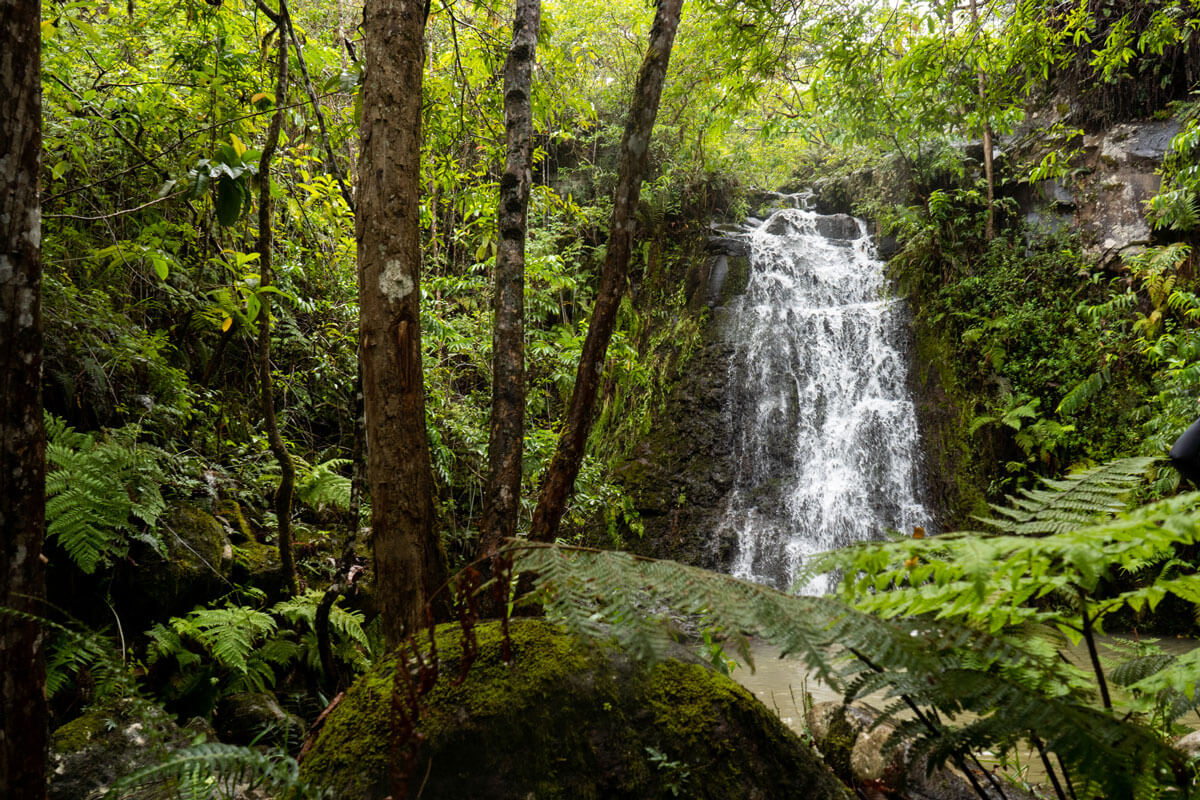
Milton Aguas carries a wooden sign over the hillside of Hacienda Guadalupe farm on Monday, March 14, 2022. Aguas plants a new tree with a sign in honor of each volunteer or special visitor to the farm. One of the only freshwater waterfalls in all of the Galápagos Islands is on the Hacienda Guadalupe farm. The waterfall is an attractive destination for ecotourism groups.
“All plants have value. You have to think about why the invasive plants were brought here in the first place. How can you say a plant is completely bad when it still has use for the land,” Aguas said.
Agua’s son, Milton Javier Aguas, 40, wants to follow his father’s political steps to improve the situation for farmers on the islands. Javier currently works with the Galápagos police on the administrative side.
Javier believes that something that can change the way people perceive production on the island should be shifting the belief that agriculture on the islands can only feed residents.
“If you look at the bigger picture, focusing on exporting can create the necessary change we need for agriculture here,” Javier said. “The reality is that there is not one clear answer on how to solve all the problems that farmers experience on the islands. As I mentioned, farms have taken the burden to educate as many people as possible, but without a concise legislative action, not much will get done in years to come.”
As farmers on the islands begin to win more battles than lose, they are starting to lay the groundwork for more conversions and, perhaps, one day, fulfilling the dream of having enough local sustainable production to feed everyone in the Galápagos.
Similar to how the islands served as a living laboratory for Charles Darwin’s theory of evolution, they now serve as a miniature microcosm of the twenty-first century, a laboratory for figuring out how humanity can meet its needs without compromising nature; overcoming several man-made challenges in the process.
Lessons from the Past to Move Forward
On the cover of each bag of coffee produced in Las Tres Marias, there is the logo of Cafe Embrujo, Vasco’s brand. The logo shows a combination of a coffee bean and Darwin’s Flycatcher, a species of bird that local ecological entities believed to be extinct. Vasco said that her main reason for choosing the bird is to create a tribute, not only for the bird but for all other species that have disappeared in recent history.
Once you disrupt the balance of an area it can take many years to recover
Coffee production has recently become the archipelago’s only agricultural export, demonstrating the economic benefits of a resource that is responsibly cultivated.
Humanity may not be able to predict or avoid all disasters, but we can learn from them. By improving what has been done before us, and actively working towards fixing it, there might be a chance to preserve our paradises.

